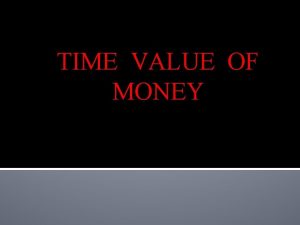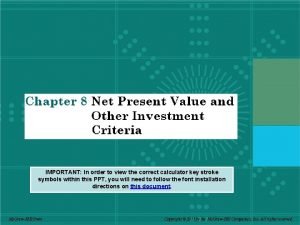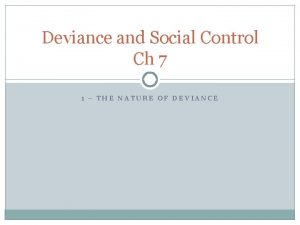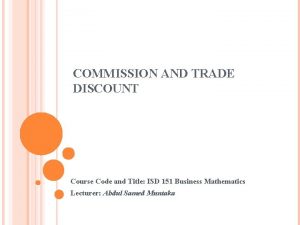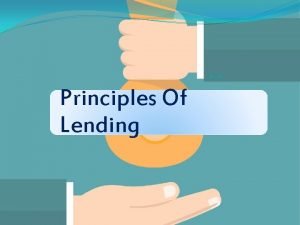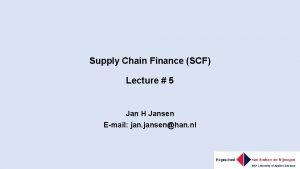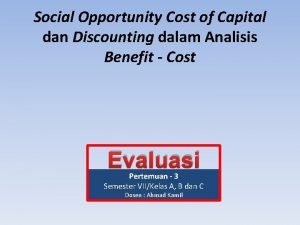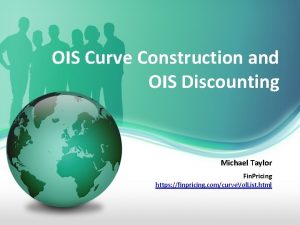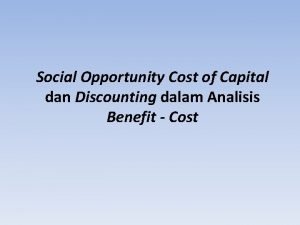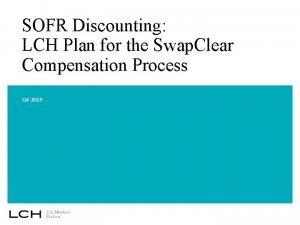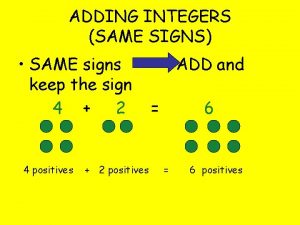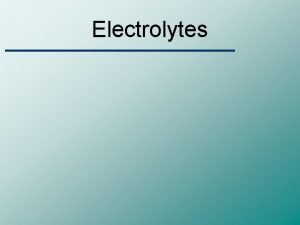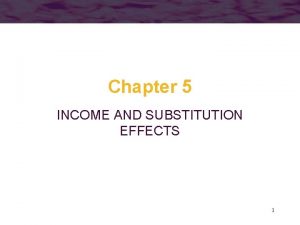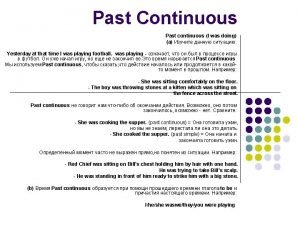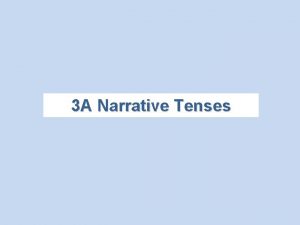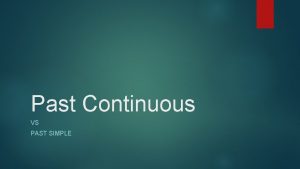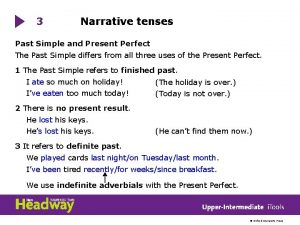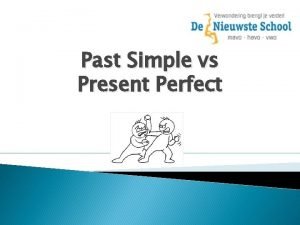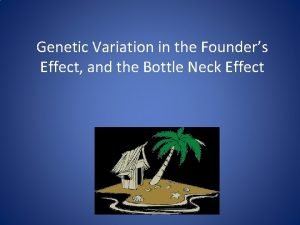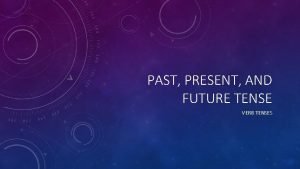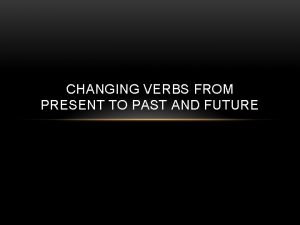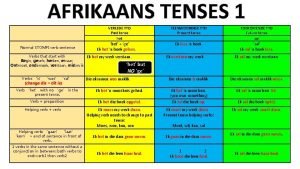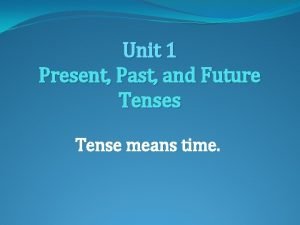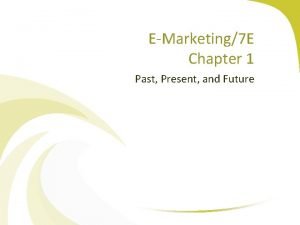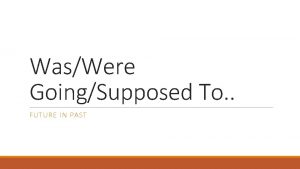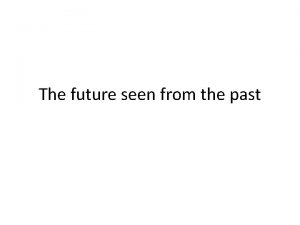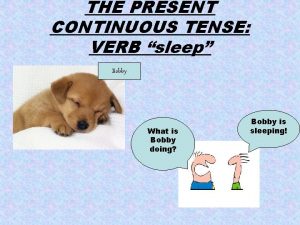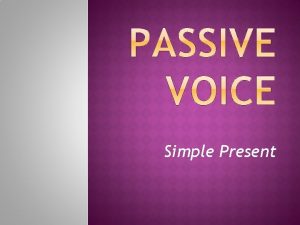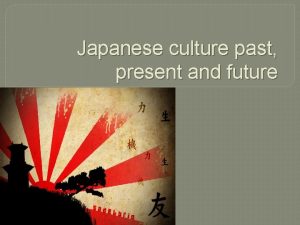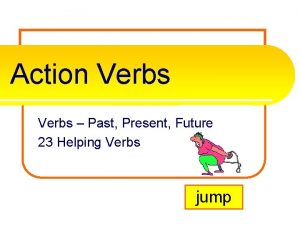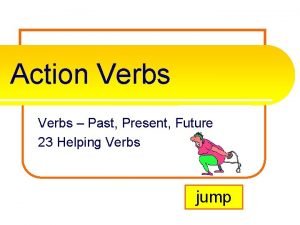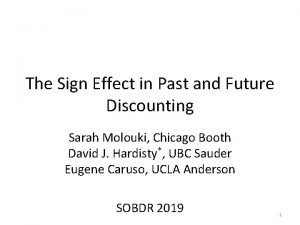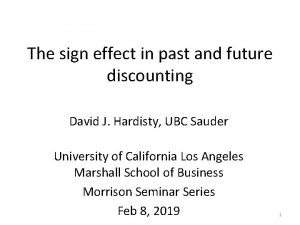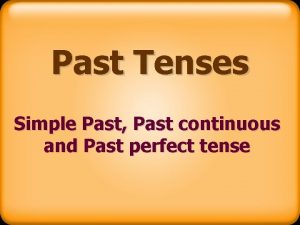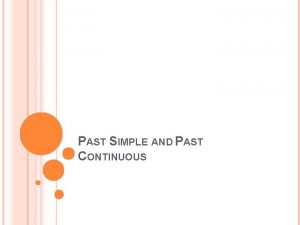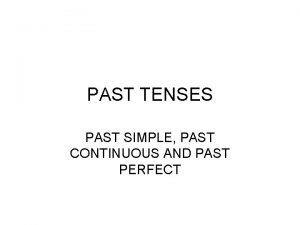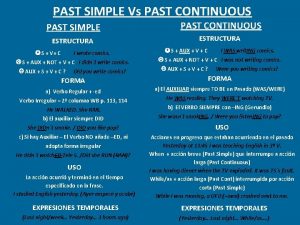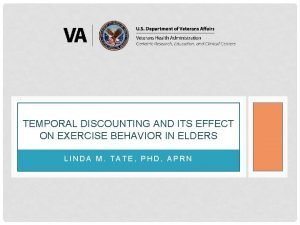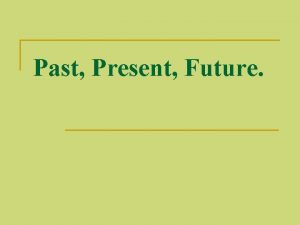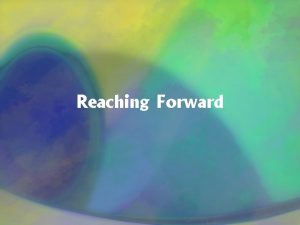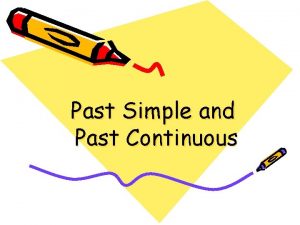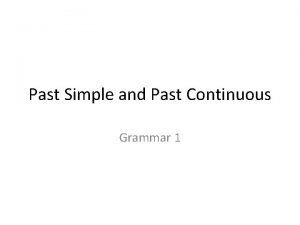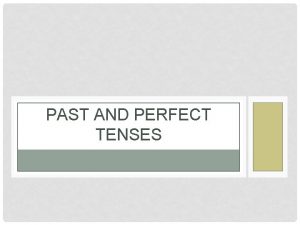The sign effect in past and future discounting


















![Experience Utility • Imagine receiving a check for $30 [paying a bill of $30] Experience Utility • Imagine receiving a check for $30 [paying a bill of $30]](https://slidetodoc.com/presentation_image/40ffc2975d81531fd6c1d75c6bfd7f50/image-19.jpg)

















![Study 3: Stimulus Please consider the following event: [50% chance of receiving $49] 1. Study 3: Stimulus Please consider the following event: [50% chance of receiving $49] 1.](https://slidetodoc.com/presentation_image/40ffc2975d81531fd6c1d75c6bfd7f50/image-37.jpg)
![Study 3: Stimulus Please consider the following event: [50% chance of paying $25] 1. Study 3: Stimulus Please consider the following event: [50% chance of paying $25] 1.](https://slidetodoc.com/presentation_image/40ffc2975d81531fd6c1d75c6bfd7f50/image-38.jpg)







































































- Slides: 109

The sign effect in past and future discounting David J. Hardisty, UBC Sauder University of California Riverside School of Business Administration Anderson Graduate School of Management Feb 5, 2019 1

Co-authors Shane Frederick Sarah Molouki Elke Weber Eugene Caruso 2

Temporal Discounting We care less about the future • Good things -> Now • Bad things -> Later Sign effect: • We want to have good things now more strongly than we want to postpone bad things (Mischel, Grusec, & Masters, 1969; Thaler, 1981; Bilgin & Le. Boeuf, 2010) 3

The Sign Effect: Across Domains Discount rates (Hardisty & Weber, 2009): • Dollar gains: 38% Environmental gains: 38% Health gains: 57% • Dollar losses: 7% Environmental losses: 11% Health losses: -1% 4

What causes the sign effect? Loss aversion Vs. Contemplation utility (also: time perception, uncertainty, and goals) 5

Loss Aversion? • Loss aversion (Tversky & Kahneman 1991): losses weigh twice as much as gains (See also : Baumeister et al 2001; Rozin & Royzman 2001) • Magnitude effect (Thaler 1981): lower discount rates for larger outcomes • Sign effect = loss aversion + magnitude effect? (Loewenstein & Prelec, 1992; Baucells & Bellezza 2017) 6

Loss Aversion? Real choices (unpublished data): • Receive $70 now or $70 in a month? 100% choose now • Pay $70 now or $70 in a month? 47% choose later • Receive $140 now or $140 in a month? 100% choose now • Pay $35 now or $35 in a month? 50% choose later 7

Contemplation Utility? • We derive pleasure and pain from contemplating future and past events (Loewenstein 1987; Baucells & Bellezza 2017) • Contemplation utility – Anticipation utility (“savoring”, “dread”, “impatience”) – Recall utility (“nostalgia”, “elation”, “regret”, “disappointment”) • Lowers discount rates 8

Kiss from a movie star: when? (Loewenstein, 1987) • “Normal” Discounting -> Now • Contemplation Utility -> Later 9

Scheduling a dental procedure • “Normal” Discounting -> Later • Contemplation Utility -> Now 10

Contemplation Utility? Asymmetry • Some evidence for “dread” effects (Berns et al 2006; Harris 2012) • Not much evidence for “savoring” effects • This asymmetry may drive the sign effect 11

Kiss from a movie star (Loewenstein 1987; N=30) 2 1. 8 1. 6 1. 4 1. 2 1 0. 8 0. 6 0. 4 0. 2 0 3 hours 24 hours 3 days 1 year Obtain four dollars Avoid losing one thousand dollars Kiss from movie star Electric shock 10 years 12

Kiss from a movie star (Replication; N=206) 2 1. 8 1. 6 1. 4 1. 2 1 0. 8 0. 6 0. 4 0. 2 0 3 hours 24 hours 3 days 1 year Obtain four dollars Avoid losing one thousand dollars Kiss from movie star Electric shock 10 years 13

Overview • Paper 1: Contemplation utility and the sign effect in the future • Paper 2: Compare the future vs the past 14

Hypotheses H 1: Contemplation of negatives > positives H 2: Contemplation -> time preferences H 3 a: Contemplation mediates the sign effect H 3 b: Wiping out contemplation utility wipes out the sign effect H 4: When controlling for loss aversion, H 1 -H 3 remain strong H 5: Contemplation of positives is mixed, but contemplation of negatives just feels bad 15

Study 1: Contemplating payment plans vs rebates • N=200 Mturkers • 2 (sign: positive vs negative) x 2 (magnitude: small vs large) between-subjects design Scenario: • “Imagine that you need to buy a new pair of glasses, and you have narrowed your choice down to two pairs, from two different brands. They are virtually identical in appearance and quality, but they offer different pricing plans. ” 16

Positive condition: Brand A costs $122. Brand B includes a rebate. It costs $142 now, but you would receive a $30 rebate in the mail after one month. Which would you choose? • Brand A: pay $122 now • Brand B: pay $142 now, and receive $30 in one month Negative condition: Brand A includes a payment plan. It costs $122 now, and you would pay an additional bill of $30 after one month. Brand B costs $142. Which would you choose? • Brand A: pay $122 now, and pay $30 in one month • Brand B: pay $142 now 17

Positive condition: Brand A costs $61. Brand B includes a rebate. It costs $71 now, but you would receive a $15 rebate in the mail after one month. Which would you choose? • Brand A: pay $61 now • Brand B: pay $71 now, and receive $15 in one month Negative condition: Brand A includes a payment plan. It costs $61 now, and you would pay an additional bill of $15 after one month. Brand B costs $71. Which would you choose? • Brand A: pay $61 now, and pay $15 in one month • Brand B: pay $71 now 18
![Experience Utility Imagine receiving a check for 30 paying a bill of 30 Experience Utility • Imagine receiving a check for $30 [paying a bill of $30]](https://slidetodoc.com/presentation_image/40ffc2975d81531fd6c1d75c6bfd7f50/image-19.jpg)
Experience Utility • Imagine receiving a check for $30 [paying a bill of $30] in one month. Would experiencing this event be pleasurable or displeasurable? (1=pleasurable, -1=displeasurable) • Imagine receiving a check for $30 [paying a bill of $30] in one month. How strongly would experiencing this event affect your feelings at that time? (0=Not at all, 50=Strongly, 100=Extremely) (Mc. Graw, Larsen, Kahneman, & Schkade, 2010) 19

Contemplation Utility • Imagine expecting to receive a check for $30 [pay a bill of $30] in one month. If this event were one month away, would the anticipation be psychologically pleasurable or displeasurable? In other words, how would you feel while waiting for it? (1=like the feeling of waiting, -1=dislike the feeling of waiting) • Imagine expecting to receive a check for $30 [pay a bill of $30] in one month. How strongly would anticipating this event affect your feelings while waiting for the event? (0=Not at all, 50=Strongly, 100=Extremely) 20

Study 1: Proportion choosing “impatient” Brand A Rebate Bill $15 42% 8% $30 56% 10% sign, b=2. 11, SE=0. 59, Wald χ2(1)=12. 69, p<. 001 magnitude, b=0. 25, SE=0. 70, Wald χ2(1)=0. 12, p=. 73 interaction, b=0. 31, SE=0. 81, Wald χ2(1)=0. 14, p=. 71 21

Contemplation Utility Study 1: Contemplation Utility 30 20 10 0 -10 -20 -30 -40 Rebate $15 Bill $30 Mediation: Sign->Contemplation->Brand Choice b=. 38, SE=. 14, CI 95 [. 17, . 74] 22

Study 1: Controlling for Loss Aversion • Method 1: include experience utility in the analyses, all key tests remain significant, p=. 001 or lower • Method 2: compare $15 bill condition with the $30 rebate condition , all key tests remain significant, p=. 002 or lower 23

Study 1: Summary & Discussion • Consumers care about future payments more than future rebates • Contemplation of losses is negative, contemplation of gains near zero • Contemplation predicts choices – Even when controlling for loss aversion • Self-report can be unreliable – Let’s manipulate contemplation, and measure real behavior 24

Study 2: Contemplating Retirement 25

Study 2: Facebook Field Study • Facebook allows AB Testing! • Advertisement Design: 2 (sign: pos vs neg) x 2 (contemplation message: absent vs present) • Budget: $50 per ad over 5 days total. • N (“reach”) = 28, 568 • DVs: – click-through-rate (CTR) – cost per click 26

Study 2: Facebook Settings • • age 19 -64 location Canada language English all devices bid cap $1 optimization: link clicks bid strategy: lowest cost 27

Study 2: contemplation msg absent 28

Study 2: contemplation msg present 29

Study 2: Facebook Results (CTR) Positive Frame Negative Frame Contemplation msg absent 1. 84% 2. 03% Contemplation msg present 2. 58% 3. 63% 30

Study 2: Facebook Results (CPC) Positive Frame Negative Frame Contemplation msg absent $0. 30 $0. 31 Contemplation msg present $0. 25 $0. 18 31

Study 2: Summary • Consumers care about future retirement expenses more than future retirement benefits • This is especially true when contemplation is emphasized 32

Study 3: Controlling for Loss Aversion • 106 participants from Amazon MTurk • Dynamically identify subjectively equivalent gains and losses for each subject • Compare anticipation for these subjectively equivalent pairs 33

Accept this pair of events? 50% chance of receiving 25 dollars AND 50% chance of paying 25 dollars Yes Unsure No 34

Accept this pair of events? 50% chance of receiving 500 dollars AND 50% chance of paying 25 dollars Yes Unsure No 35

Accept this pair of events? 50% chance of receiving 49 dollars AND 50% chance of paying 25 dollars Yes Unsure No 36
![Study 3 Stimulus Please consider the following event 50 chance of receiving 49 1 Study 3: Stimulus Please consider the following event: [50% chance of receiving $49] 1.](https://slidetodoc.com/presentation_image/40ffc2975d81531fd6c1d75c6bfd7f50/image-37.jpg)
Study 3: Stimulus Please consider the following event: [50% chance of receiving $49] 1. Assuming this event would definitely happen to you and you knew it were coming, when would you prefer it to happen? Immediately OR in one week 37
![Study 3 Stimulus Please consider the following event 50 chance of paying 25 1 Study 3: Stimulus Please consider the following event: [50% chance of paying $25] 1.](https://slidetodoc.com/presentation_image/40ffc2975d81531fd6c1d75c6bfd7f50/image-38.jpg)
Study 3: Stimulus Please consider the following event: [50% chance of paying $25] 1. Assuming this event would definitely happen to you and you knew it were coming, when would you prefer it to happen? Immediately OR in one week 38

Study 3: Stimulus Please consider the following event: [get a free, relaxing massage for 50 minutes] 1. Assuming this event would definitely happen to you and you knew it were coming, when would you prefer it to happen? Immediately OR in one week 39

Study 3: Stimulus Please consider the following event: [spend time stuck in horrible traffic for 45 minutes] 1. Assuming this event would definitely happen to you and you knew it were coming, when would you prefer it to happen? Immediately OR in one week 40

Study 3: Stimulus Please consider the following event: [a complimentary dinner at a restaurant of your choice] 1. Assuming this event would definitely happen to you and you knew it were coming, when would you prefer it to happen? Immediately OR in one week 41

Study 3: Stimulus Please consider the following event: [endure 10 mild (and harmless) electric shocks] 1. Assuming this event would definitely happen to you and you knew it were coming, when would you prefer it to happen? Immediately OR in one week 42

Time preferences Gains Losses Now 79% 57% In one week 21% 43

Time preferences Gains Losses Now 79% 57% In one week 21% 43% 44

Study 3: Stimulus 2. a. Please imagine this event happening one week from now. Would experiencing this event be pleasurable or unpleasurable? Pleasurable experience OR unpleasurable experience 2. b. How strongly would experiencing this event affect your feelings at that time? not at all strongly extremely |-------------------------------------| (Wording based on Mc. Graw et al, 2010) 45

Study 3: Stimulus 3. a. If this event were one week away, would the anticipation be psychologically pleasurable or unpleasurable? In other words, how would you feel while waiting for it? Like the feeling of waiting OR Dislike the feeling of waiting 3. b. How strongly would anticipating this event affect your feelings while waiting for the event? not at all strongly extremely |-------------------------------------| 46

Utility for experience and anticipation 60 Mean Utility 40 Gain Loss 20 0 -20 -40 -60 Experience Anticipation 47

Study 4: Why asymmetric? Hypothesis • We enjoy contemplating future gains • We dislike contemplating future losses • BUT: We rarely enjoy contemplating future losses 48

Study 4: Methods 105 participants from Amazon MTurk 10 positive & 10 negative events Time preference Two questions for anticipation: …how pleasurable or happy would the anticipation be? • …how displeasurable or unhappy would the anticipation be? • • • 49

Study 4 Results 70 60 Positive Anticipation 50 40 30 20 10 0 Positive Events Negative Events 50

Paper 1: Summary H 1: Contemplation of negatives > positives H 2: Contemplation -> time preferences H 3 a: Contemplation mediates the sign effect H 3 b: Wiping out contemplation utility wipes out the sign effect (Study 5, not shown) H 4: When controlling for loss aversion, H 1 -H 3 remain strong H 5: Contemplation of positives is mixed, but contemplation of negatives just feels bad 51

Paper 2: The sign effect in past and future discounting 52

Paper 2: Future vs Past, A critical test of the sign effect • We discount past events, even more than future events (Caruso, Gilbert, & Wilson, 2008; Brandimarte, Vosgerau & Acquisti 2018) • Sign effect in the past? (for non-moral events) • Loss aversion account: Sign effect should be the same in the past • Contemplation account: Sign effect should be reduced or eliminated in the past 53

Overview • Study 1: Discounting and contemplation of hypothetical events • Study 2: Contemplation of real jellybeans • Study 3 (summary): Fancier version of Study 1 • Study 4 (if time): The role of uncertainty 54

Study 1 a Sign x Tense with money 55

Study 1 a: Methods • 184 Mturkers • 2 (gain vs loss) x 2 (future vs past) • Within subjects, counterbalanced • Gains (~$10) twice as big as losses (~$5) 56

57

58

Study 1 a: Contemplation Utility 59

Study 1 a: Discounting Results 60

Study 1 a: Contemplation Utility Results 61

Study 1 a: Mediation 62

Study 1 b Sign x Tense with hedonic events 63

Study 1 b: Methods • 186 Mturkers • Same design as Study 1 a Stimuli: • Pos: receiving a pleasant 1 hour massage • Neg: receiving an unpleasant (but nonharmful) 1 minute electric shock 64

65

Study 1 b: Discounting 66

Study 1 b: Contemplation utility 67

Study 1 b: Mediation 68

Study 1: Discussion • Sign effect eliminated in past discounting • Contemplation utility: – shows a similar pattern – Mediates the sign X tense interaction Study 2: • Real outcomes • Rule out demand/consistency effects • Why is contemplation utility of future gains so low? – Contemplation of future positives is a mixed experience – Contemplation of other events is unipolar 69

Study 2: Real Events 70

Study 2: Stimuli 71

Study 2: Methods • 100 university students 2 x 3 design: • Flavor: pos vs neg, between subjects • Time: future vs present vs past, within subjects: T 1: Predicted experience and current anticipation 15 minutes filler tasks T 2: Rate experience 15 minutes filler T 3: Remembered experience and current recall utility 72

Study 2: Methods T 1 The flavor you have been assigned to is: dirt_____ 15 minutes from now, you will be eating this jelly bean. 73

T 1 Experience prediction 74

T 1 Contemplation utility 75

T 2 Experience ratings 76

T 3 Experience Memory 77

T 3 Contemplation Utility 78

Contemplation Utility Study 2 Results: Contemplation Utility 9 8 7 6 5 4 3 2 1 0 -1 FUTURE positive event PAST negative event 79

Study 2 Results: Contemplation Utility Strength of Emotion 12 Flavor: Good Bad 10 8 *** n. s. *** 6 4 2 0 FUTURE positive emotion PAST negative emotion 80

Study 2: Discussion • Contemplation of future positive is a mixed experience • Contemplation of future negative is a negative experience • Contemplation of past positives and negatives are unipolar 81

Study 3 Alternative explanations 82

Study 3: Methods • Similar design to Study 1: – Future vs past – Positive vs negative – Money vs hedonic • N = 400 MTurkers 83

Study 3: Methods • Individually titrate loss aversion. Median results: – $10 gain = $5 loss – 60 minute massage = 10 second electric shock • A dynamic measure of discounting with greater range and precision (To. AD, Yoon & Chapman 2016) • Measured alternative processes: – Connection to future/past self – Thought frequency • Measure and adjusted for utility curvature 84

Study 3: Financial Utility Curvature Utility 1 0. 5 -$25. 00 -$15. 00 -$5. 00 0 $5. 00 $15. 00 $25. 00 -0. 5 -1 85

Study 3: Hedonic Utility Curvature Utility 1 0. 5 -100 -80 -60 -40 -20 0 0 20 40 60 80 100 Minutes of massage Seconds of electric shock -0. 5 -1 86

Study 3: Summary of Results • Key results replicated: – Discount rates – Contemplation utility – Mediation • Adjusting for utility curvature: no effect • Connection to distant self & thought frequency: – Predict discount rates – Do not explain the sign X tense interaction 87

Study 4: Uncertainty could also explain the sign effect: • People are risk averse for both gains and losses in intertemporal choice (Hardisty & Pfeffer, 2017) • The future is unavoidably uncertain -> sign effect • The past is more certain -> sign effect is wiped out 88

Study 4: Methods • 201 Mturkers told they will look at 10 photos of puppies or cockroaches (between-subjects), in 5 minutes Three different measures of uncertainty: • “How certain are you that you will see the [puppy] photos? ” • “How certain are you about how much you will like or dislike the [puppy] photos? In other words, how certain are you about how you will react to the [puppy] photos? ” • “Please consider your uncertainty about the [puppy] photos. How does the uncertainty make you feel? ” 0=I strongly dislike the feeling of uncertainty, 100=I strongly like the feeling of uncertainty 89

Study 4: Methods • Time preference • Contemplation utility • 5 min distractor task 90

91

92

93

94

95

96

Study 4: Methods • • • 5 min distractor task Past uncertainty questions Past time preference Past contemplation utility Need for Cognitive Closure (NFC) Ambiguity Tolerance (MSTAT) 97

Study 4 Results: Time Prefs Cockroach Puppy Prosp Now Pref 80% 52% Retro Now Pref 27% 49% 98

Contemplation Utility Study 4 Results: Contemplation 60 50 40 30 20 10 0 FUTURE Puppies PAST Cockroaches Also: mediation with contemplation utility replicates 99

Uncertainty Results • The future is more uncertain than the past – this does not predict time preferences • People weren’t as sure about their reaction to past cockroaches – this does not predict time preference • We don’t like feelings of uncertainty about puppies or cockroaches – This predicts contemplation utility – This does not predict time preferences • Uncertainty attitude (NFC, MSTAT) predicts contemplation utility, but not time preferences 100

Conclusions • We discount gains more than losses in the future, but not in the past • The sign effect is NOT explained by loss aversion • The sign effect is partly explained by differences in contemplation utility: – Anticipation of future positive events is a mixed emotion – Recall of past positive events feels good – Contemplation of future and past losses always feels bad 101

Thank you! 102

Extra Slides 103

Study 5: Contemplating Jellybeans • Perhaps contemplation of real events is different in important ways • 2 nd goal: Rule out demand characteristics • How can we give matched positive and negative experiences in the lab? 104

Study 5: Methods • Randomly assigned to “Dirt” or “Toasted marshmallow” flavor jellybean (pretested) • (Jellybeans visible in the experimental room) • Everyone must wait one week to eat the jellybean • Rated predicted experience utility and anticipation utility 105

40 30 Dirt 20 Toasted Marshmallow 10 0 -10 -20 -30 -40 -50 Predicted Experience Utility Anticipation Utility 106

Study 6: Eliminating contemplation • Wiping out contemplation should wipe out the sign effect • Design: 2 (pos vs neg) x 2 (choose for self vs other) between subjects, N=175 undergraduates Jellybean flavors: • Glazed Blueberry Cake (Good-tasting with sweet aftertaste) • French Vanilla (Good-tasting with sweet aftertaste) • Soap (Bad-tasting, soapy flavor with sweet aftertaste) • Black Pepper (Bad-tasting, spicy flavor with sweet aftertaste) 107

Study 6: choosing “immediately” Choose for self Choose for other Good Flavor Bad Flavor 73% 81% 58% 108

Study 6: “discounting” Choose for self Choose for other Good Flavor Bad Flavor 73% 19% 58% 42% 109
 All the signs for driving
All the signs for driving See future perfect
See future perfect Future continuous and future perfect
Future continuous and future perfect Past perfect continuous vs past continuous
Past perfect continuous vs past continuous Past simple i past continuous i past perfect
Past simple i past continuous i past perfect Compounding dan discounting adalah
Compounding dan discounting adalah Mirr method
Mirr method Strain theory examples
Strain theory examples Cash discount and remittance calculations examples
Cash discount and remittance calculations examples Exponential discounting
Exponential discounting Bill discounting
Bill discounting Standard definitions for techniques of supply chain finance
Standard definitions for techniques of supply chain finance Npv adalah
Npv adalah Ois curve
Ois curve What is acceptance house
What is acceptance house Social opportunity cost
Social opportunity cost Opportunity cost principle
Opportunity cost principle Lch discounting
Lch discounting Fundamental concepts of managerial economics
Fundamental concepts of managerial economics Kernig's sign
Kernig's sign Same sign keep and add
Same sign keep and add Past simple past perfect past continuous exercises
Past simple past perfect past continuous exercises Past perfect continuous past continuous
Past perfect continuous past continuous Cuong nguyen md
Cuong nguyen md Trosseau sign
Trosseau sign Chvostek sign trousseau sign
Chvostek sign trousseau sign Future continuous and future perfect
Future continuous and future perfect Tense
Tense Future plans and finished future actions
Future plans and finished future actions Future perfect x
Future perfect x Nulti i prvi kondicional
Nulti i prvi kondicional Bohr effect and haldane effect
Bohr effect and haldane effect Income effect graph
Income effect graph Past perfect past progressive
Past perfect past progressive Past simple past continuous past perfect таблица
Past simple past continuous past perfect таблица Narrative tenses past continuous
Narrative tenses past continuous Continuos
Continuos Narrative tenses past simple past perfect past continuous
Narrative tenses past simple past perfect past continuous Fyne jas
Fyne jas Perfect future tense
Perfect future tense Present past future simple
Present past future simple Future nurse future midwife e learning
Future nurse future midwife e learning Present continuous for future
Present continuous for future Plans present continuous
Plans present continuous Bottleneck effect
Bottleneck effect Hình ảnh bộ gõ cơ thể búng tay
Hình ảnh bộ gõ cơ thể búng tay Bổ thể
Bổ thể Tỉ lệ cơ thể trẻ em
Tỉ lệ cơ thể trẻ em Voi kéo gỗ như thế nào
Voi kéo gỗ như thế nào Tư thế worm breton
Tư thế worm breton Chúa yêu trần thế
Chúa yêu trần thế Các môn thể thao bắt đầu bằng tiếng chạy
Các môn thể thao bắt đầu bằng tiếng chạy Thế nào là hệ số cao nhất
Thế nào là hệ số cao nhất Các châu lục và đại dương trên thế giới
Các châu lục và đại dương trên thế giới Công của trọng lực
Công của trọng lực Trời xanh đây là của chúng ta thể thơ
Trời xanh đây là của chúng ta thể thơ Mật thư anh em như thể tay chân
Mật thư anh em như thể tay chân Làm thế nào để 102-1=99
Làm thế nào để 102-1=99 Phản ứng thế ankan
Phản ứng thế ankan Các châu lục và đại dương trên thế giới
Các châu lục và đại dương trên thế giới Thể thơ truyền thống
Thể thơ truyền thống Quá trình desamine hóa có thể tạo ra
Quá trình desamine hóa có thể tạo ra Một số thể thơ truyền thống
Một số thể thơ truyền thống Cái miệng xinh xinh thế chỉ nói điều hay thôi
Cái miệng xinh xinh thế chỉ nói điều hay thôi Vẽ hình chiếu vuông góc của vật thể sau
Vẽ hình chiếu vuông góc của vật thể sau Nguyên nhân của sự mỏi cơ sinh 8
Nguyên nhân của sự mỏi cơ sinh 8 đặc điểm cơ thể của người tối cổ
đặc điểm cơ thể của người tối cổ Thế nào là giọng cùng tên?
Thế nào là giọng cùng tên? Vẽ hình chiếu đứng bằng cạnh của vật thể
Vẽ hình chiếu đứng bằng cạnh của vật thể Tia chieu sa te
Tia chieu sa te Thẻ vin
Thẻ vin đại từ thay thế
đại từ thay thế điện thế nghỉ
điện thế nghỉ Tư thế ngồi viết
Tư thế ngồi viết Diễn thế sinh thái là
Diễn thế sinh thái là Dot
Dot Bảng số nguyên tố
Bảng số nguyên tố Tư thế ngồi viết
Tư thế ngồi viết Lời thề hippocrates
Lời thề hippocrates Thiếu nhi thế giới liên hoan
Thiếu nhi thế giới liên hoan ưu thế lai là gì
ưu thế lai là gì Hổ đẻ mỗi lứa mấy con
Hổ đẻ mỗi lứa mấy con Sự nuôi và dạy con của hươu
Sự nuôi và dạy con của hươu Sơ đồ cơ thể người
Sơ đồ cơ thể người Từ ngữ thể hiện lòng nhân hậu
Từ ngữ thể hiện lòng nhân hậu Thế nào là mạng điện lắp đặt kiểu nổi
Thế nào là mạng điện lắp đặt kiểu nổi Future simple present continuous
Future simple present continuous Hop future tense
Hop future tense What changes in the present past and future
What changes in the present past and future Present tense in afrikaans
Present tense in afrikaans Future tense of float
Future tense of float Consider simple past
Consider simple past Simple present past and future
Simple present past and future Future simple examples
Future simple examples E marketing past present and future
E marketing past present and future Was/were going to future in the past
Was/were going to future in the past Future seen from the past
Future seen from the past Simple present simple past simple future exercises
Simple present simple past simple future exercises Simple past simple present simple future
Simple past simple present simple future Present simple present continuous past simple future simple
Present simple present continuous past simple future simple Present simple past simple future simple
Present simple past simple future simple What is the simple present tense of sleep
What is the simple present tense of sleep Cortar present perfect
Cortar present perfect Be past tense
Be past tense Past perfect of set
Past perfect of set Past present future in japanese
Past present future in japanese Helping verbs 23
Helping verbs 23 Maybe mr do should have a will
Maybe mr do should have a will He who controls the past commands the future
He who controls the past commands the future





